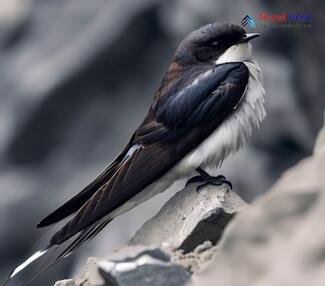Nestled amongst the astonishing landscapes and rich biodiversity of Nepal, the Nepal House Martin (Delichon nipalense) is a fascinating bird species that are truly worth discovering. With a unique presence in this Himalayan country, these beautiful birds are a must-see for any nature enthusiast or birdwatcher visiting the region. In this article, we will delve into the captivating details of the Nepal House Martin and explore its prominence in Nepal's extraordinary ecosystem.
An Overview of the Delichon Nipalense
The Nepal House Martin is a small, migratory passerine bird belonging to the swallow family, Hirundinidae. Measuring about 13 centimeters in length, this species boasts an attractive plumage with bluish-black upperparts and white underparts, giving it a striking appearance against its natural surroundings. The triangular tail and black band across their chest provide additional distinguishing features for this remarkable bird.
Presence in Nepal
The primary range of the Nepal House Martin encompasses the mountainous regions of central Asia, with a significant presence observed within the boundaries of Nepal. This bird species can be found inhabiting elevations between 1,900 to 4,200 meters above sea level in various parts of the country. Open woodlands, high cliffs scattered with vegetation, and proximity to flowing water sources are among their preferred habitats.
A principal nesting area for the species lies within Langtang National Park, where several breeding colonies can be observed during their breeding season from April to August. The birds utilize mud nests built on vertical cliff faces to raise their young; these nests are strategically located to provide an effective barrier against potential predators and thus enhance the survival rate of their offspring.
Migration Patterns
Being a migratory species, the Nepal House Martin embarks on an impressive journey between its breeding grounds in Nepal and its wintering grounds, which are primarily located in India. These resilient birds undertake this arduous journey twice a year, once in the autumn and again during the spring.
The Importance of Conservation Efforts
Given their status as a near-threatened species, it is crucial to emphasize conservation efforts to ensure the continued presence of the Nepal House Martin. Habitat conservation, including safeguarding critical nesting sites and preserving essential food sources, is a key component of these efforts. Additionally, educating locals and visitors about this unique bird species can help encourage respect for their habitats and contribute towards their long-term survival.
In Conclusion
The Nepal House Martin is an incredible species that adds to the richness of Nepal's vibrant biodiversity. As you explore the stunning landscapes of this breathtaking country, keep an eye out for these splendid birds and take a moment to appreciate their remarkable presence amidst the grandeur of nature. And with increasing awareness and concerted conservation initiatives, we can look forward to future generations being able to admire these charming avian treasures as well.




